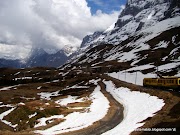Az előző bejegyzésben elindultuk Nápolyból és kis-Amalfiként emlegetett tengerpart, egy albán falu, óriási feketefenyők, egy középkori tengerparti erőd és egy gyönyörű bizánci templom érintésével ismerkedtünk Calabriával. Jöjjön akkor az út második része:
In the previous post we left Naples, drove through a stretch of coast known as little Amalfi, then visited an Albanian village, gigantic pines, a medieval fort by the sea and a stunning Byzantine church as we were getting acquainted with Calabria. Now let's see the second part of the trip:
 |
| Szinte egyedül voltunk a Palizzi felé vezető kanyargós hegyi utakon. We were practically alone as we headed up the winding mountain roads toward Palizzi. |
 |
| Teljesen egyedül azért nem voltunk: kecsék például időnként átmentek az úton. We weren't totally alone though: a few goats did cross the road occasionally. |
 |
| Chianalea utcáin On the streets of Chianalea |
 |
| Gyertyafényes vacsora a tenger partján: romantika kimaxolva... Candelight dinner right by the sea: could it be more romantic... |
 |
| ...másnap reggel pedig erre a kilátásra ébredtünk. ...the view we woke up to the next morning was quite impressive too. |
 |
| Indulunk tovább Scillából. We're leaving Scilla and are on our way again. |
| ||
| Az egyik legszebb sétát CAPO VATICANO mellett tettük, ahol a sziklák tetején kiépített ösvényről néztük a vizet. One of the nicest walks we took was at CAPO VATICANO, atop the rising cliffs and overlooking the sea. |
 |
| Kora délután értünk TROPEA városába. A város közepén, a szikladombra épült Santuario di Santa Maria templom árnyékában fürödtünk egyet a kristálytiszta tengerben, utána körbejártuk az óvárost. We arrived in TROPEA in the early afternoon. We swam in the crystal clear sea right in the center, next to the rocky hill crowned by the Santuario di Santa Maria church. |
 |
| Meredek sziklafalak mindenütt: Tropea elhelyezkedése sem akármilyen. Tropea also has a stunning location with its sheer cliffs. |
 |
| Közvetlenül az óváros mellett (Piazza Cannone) van egy nagyon klassz Belvedere, azaz kilátó. Itt vártuk a naplementét. We waited for the sunset at a great little Belvedere (viewpoint) just outside the old town (Piazza Cannone). |
 |
| Ez nem photoshop, hanem az egyik legszebb naplemente, amit eddig láttam. Volt még ezután esti séta Tropeában, reggeli kávézás tengeri kilátással, aztán a visszaút Nápolyba, de ezzel a képpel zárom a bejegyzést. 8 nap és bő 1000 km megtétele után egyértelmű volt, hogy Olaszország legszegényebb és legkevésbé ismert régiója is nagyon sok élményt tud nyújtani. Megérte végigjárni Calabriát. This isn't photoshop, it's one of the most beautiful sunsets I've seen so far. At this point we still had some things to look forward to, like an evening walk in Tropea, coffee with seaview the next morning and the drive back to Naples, but it is this view that I'm closing this post with. After 8 days and more than 600 miles, it was clear that the poorest and least known region of Italy is still a wonderful place that offers a lot. Was it worth exploring Calabria? Definitely yes. |












